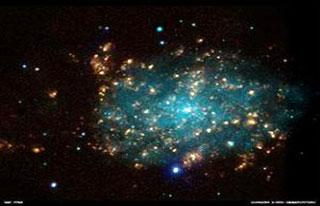
The galaxy NGC 7793. This image combines X-ray and optical data taken with three telescopes. Photo: X-ray (NASA/CXC/Univ of Strasbourg/M. Pakull et al); Optical (ESO/VLT/Univ of Strasbourg/M. Pakull et al); H-alpha (NOAO/AURA/NSF/CTIO 1.5m)
CANBERRA, AUSTRALIA (BNS): Massive black holes are more powerful than we thought. That's what astronomers have concluded after using a CSIRO telescope to study what is in effect a miniature galaxy buried inside a normal-sized one, like a Russian doll.
An international team of astronomers led by Dr Manfred Pakull at the University of Strasbourg in France has discovered a ‘microquasar’ – a small black hole, weighing only as much as a star, which shoots jets of radio-emitting particles into space.
Called S26, the black hole sits inside a regular galaxy called NGC 7793, which is 13M light-years away in the Southern constellation of Sculptor.
Scientists have made new observations with CSIRO's Compact Array radio telescope near Narrabri, NSW which shows that S26 is a near-perfect analogue of the much larger 'radio galaxies' and 'radio quasars', as reported in a news release by the Commonwealth Scientific and Industrial Research Organisation (CSIRO).
Astronomers have been working for decades to understand how these black holes form their giant jets, and how much of the black hole’s energy those jets transmit to the gas they travel through. That gas is the raw material for forming stars, and the effects of jets on star-formation have been hotly debated.
"Measuring the power of black hole jets, and therefore their heating effect, is usually very difficult, but with this unusual object, a bonsai radio quasar in our own backyard, we have a unique opportunity to study the energetics of the jets," co-author Roberto Soria (University College London), who carried out the radio observations, was quoted as saying in the report.
Using their combined optical, X-ray and radio data, the scientists were able to determine how much of the jet’s energy went into heating the gas around it, and how much went into making the jet glow at radio wavelengths.
They concluded that only about a thousandth of the energy went into creating the radio glow.
"This suggests that in bigger galaxies too the jets are about a thousand times more powerful than we’d estimate from their radio glow alone. That means that black hole jets can be both more powerful and more efficient than we thought, and that their heating effect on the galaxies they live in can be stronger," added Dr Tasso Tzioumis of CSIRO Astronomy and Space Science.
The study was made possible by a recent upgrade to the Compact Array, which can now do work of this kind five times faster than before.
 Previous Article
Previous Article Next Article
Next Article












The Indian Air Force, in its flight trials evaluation report submitted before the Defence Ministry l..
view articleAn insight into the Medium Multi-Role Combat Aircraft competition...
view articleSky enthusiasts can now spot the International Space Station (ISS) commanded by Indian-American astr..
view article